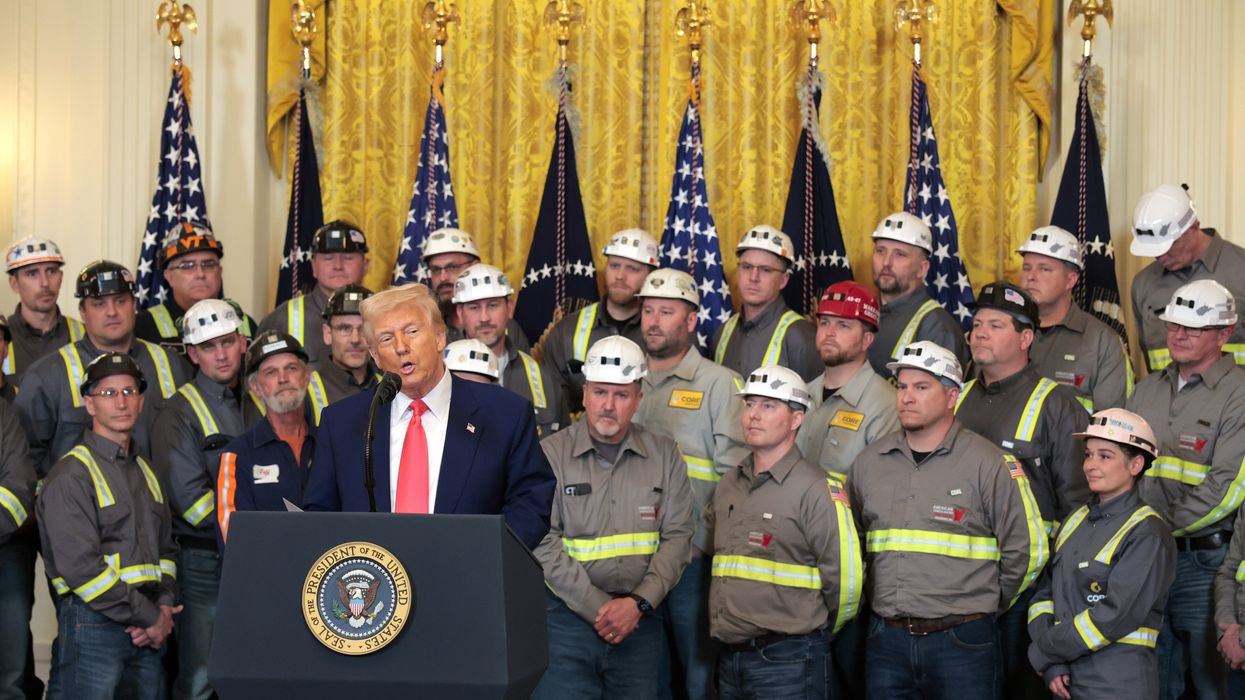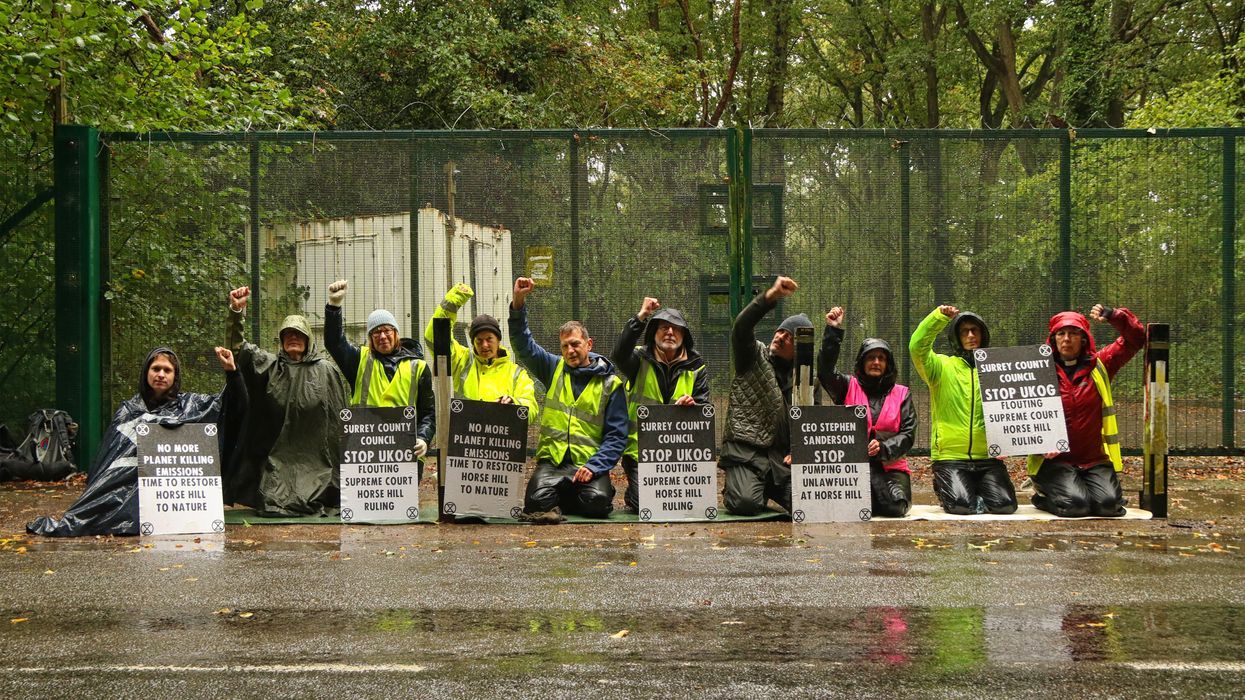Trump and Wright Are Turning America Into a Gas Station Masquerading as a Nation
Much of what they’ve been doing—from cutting funding for the arts to cancelling major renewable projects—seems designed to insure that fracked gas will be our central legacy.
Way back in January of 2015, six months before Donald Trump began America’s escalator-like descent, Sen. John McCain of Arizona took to the floor of the Senate to describe Russia as “a gas station masquerading as a country.” He was responding to the invasion of Crimea, and demanding the US stand up to Moscow; within a few weeks others has shortened his bon mot to “gas station with nukes.” It hit at an essential truth: Russia, for all its size and might, hadn’t developed much of anything in recent decades; Vladimir Putin survived by pumping gas to the rest of the world, resting on the weapons his Soviet predecessors had bequeathed him.
Eight months into the second Trump administration, what are we? The president and his minions have been enriching themselves, and doing it by stripping the state that better women and men had built in the decades before. Our scientific and medical prowess? Our great universities? Our shared culture, from public broadcasting to the National Endowment for the Arts to the Kennedy Center? Even our history, as the Smithsonian comes under attack. But we still have a lot of fracked gas, dammit! And—viewed one way—much of what they’ve been doing seems designed to insure that fracked gas will be our central legacy.
On the list of odd things the administration has done, shutting down work on offshore wind projects off the New England coast may be among the oddest. These projects are enormous investments, have been in the works for many years, and have acquired (with painful slowness) the necessary permits. Now, just as they’re coming online, they’re being shut down. I can’t really think of any equivalent—it’s as if, in the 19th century we built the Erie Canal and then decided, forget it, let’s keep using wagons. It’s as if in the 20th century, we built the interstate highway system and then decided to simply seal off the exits and let it just lie there unused. What kind of logic turns a paid-for and productive asset into an aqueous Stonehenge?
This kind of logic: If those turbines start funneling electricity into New England, they won’t need to burn as much natural gas to produce electricity. They won’t need the new pipelines that Big Oil wants to build north. And who would that hurt? Well, Christopher Wright is Trump’s secretary of energy. He was formerly CEO of Liberty Energy, the nation’s second-largest fracking firm. Here’s how the Energy Department describes his background (after describing him as a “dedicated humanitarian”):
He founded Pinnacle Technologies and served as CEO from 1992 to 2006. Pinnacle created the hydraulic fracture mapping industry, and its innovations helped launch commercial shale gas production in the late 1990s. Chris was chairman of Stroud Energy, an early shale gas producer, before selling to Range Resources in 2006. Most recently, Chris served as chairman and CEO of Liberty Energy, where his team helped to expand the shale revolution to include oil as well as natural gas.
And here’s Christopher Wright, speaking at the Council on Foreign Relations on the eve of a trip to Europe next week to “promote American gas.” According to him, the Paris climate accords are “silly” and “climate change, for impacting the quality of your life, is not incredibly important. In fact, if it wasn’t in the news, in the media, you wouldn’t know.”
I have my guesses how well this will go down with Wright’s European hosts—the continent has just endured its worst wildfire season since record-keeping began. Portugal, Spain, and Greece have been especially hard hit; France recorded its biggest wildfire since at least 1949, which shrouded much of the country in smoke. As one local mayor said, “Everything is burned. More than half or three-quarters of the village has burned down. It’s hellish, a lunar landscape.” Even that green and pleasant isle of England has had its worst fire season ever, which makes sense since it was the hottest summer in UK history.
But for the moment let’s forget about Europe, and indeed about climate change, and instead focus on East Coast electricity users, because they’ll be paying the highest price for Wright’s folly. Canary Media’s Jeff St. John, in an epic account last week, laid out the costs of shutting down a massive source of supply that regional energy planners had been counting on:
It would leave a gaping hole in New England’s energy mix, driving up the region’s already-high electricity prices and leaving its grid more vulnerable to collapse during winter storms. New England’s grid operator has already factored the 704-megawatt wind farm into its plans starting next year. Delaying delivery of that power “will increase risks to reliability,” ISO New England warned in a statement last week.
In fact, that warning from the ISO, or Independent System Operator, in New England is worth reading. It comes from a largely anonymous agency charged with keeping the region online:
“Unpredictable risks and threats to resources—regardless of technology—that have made significant capital investments, secured necessary permits, and are close to completion will stifle future investments, increase costs to consumers, and undermine the power grid’s reliability and the region’s economy now and in the future,” ISO New England said in the statement.
That’s not the language these guys usually use. Abe Silverman, a Johns Hopkins researcher, called it “unprecedented.” But then, so is taking a huge energy generator offline for no reason:
“We’re talking about a really significant hit to consumers, at a time we’re all hyper-concerned about inflation and energy prices generally,” Silverman said. Losing Revolution Wind’s electricity could cost New England consumers about $500 million a year, he estimated, based on the value the project has secured in ISO New England’s forward capacity market and its potential to supplant costlier power plants used during grid emergencies.
And “we don’t need a bunch of fancy studies to tell us that these units are needed for reliability,” he said. New England has long struggled to meet electricity demand during winter cold snaps and summer heatwaves. When temperatures surpassed 100°F for several days in June, “they had every single generator on,” he said. “Here we have a unit that should be operating as of next summer that is now in doubt.”
But it’s during the winter months that the loss of Revolution Wind could be most keenly felt, said Susan Muller, a senior energy analyst at the Union of Concerned Scientists. That’s when the region’s limited supply of fossil gas is stretched even thinner, since the fuel is used both for building heating and power generation. ISO New England is banking on offshore wind—which blows most strongly in the winter—to meet energy needs as temperatures plummet.
As the Times reported, “Revolution Wind was expected to generate electricity for more than 350,000 homes at 9.8 cents per kilowatt-hour, a rate that would be locked in for 20 years and is cheaper than the average cost of electricity in New England, according to America’s Clean Power.” In fact, a new study released last week found that if Revolution Wind had been in operation last year, it would have saved consumers $400 million, lowering their energy prices 11% and “insulating ratepayers from expensive, volatile natural gas.” Given America’s insane levels of inequality, that might not mean much to “humanitarian” Wright: he sold his fracking stock for $53 million when he took the Energy Department job. But I live in New England—I know lots of people who have trouble paying their power bills.
There is no mystery here. Across the country, as Princeton’s Jesse Jenkins was the latest to point out, the old canard about renewable electricity being expensive is simply not true—many states with more wind have cheap power prices. It’s not less reliable; with new batteries just the opposite is true. In fact, in the heart of the shale fracking belt in Texas, the head of the state’s Energy Reliability Council said earlier this summer that its blackout risk had been greatly reduced. Read the numbers here to get a sense of how backwards Wright and Trump have it:
The addition of more than 9,600 megawatts of capacity to the state’s grid since last summer, coupled with conservative operations and reliable management, has produced this result, Vegas said at an ERCOT board of directors meeting this week.
“The state of the grid is strong, it is reliable—it is as reliable as it has ever been and it is as ready for the challenges of extreme weather,” Vegas said. “I feel confident that we are ready for this upcoming summer season.”
Of the new capacity added, 5,395 megawatts came from solar, 3,821 megawatts from energy storage and 253 megawatts from wind power. Kristi Hobbs, ERCOT’s vice president of system planning and weatherization, said the risk of emergency as the sun goes down and Texans continue to pump their air conditioners has been greatly reduced due to the large contributions from solar and battery storage.
“That does put us in a better position to get over those evening ramps as we go into late summer,” Hobbs said.
In the same time frame of the solar and storage additions, there’s been a net loss of natural gas capacity. Retirements, deactivations, and derates, or a loss of available capacity, of gas plants, resulted in a reduced capacity of 366 megawatts on the grid since last summer.
I am pretty sure that Christopher Wright knows all this. He tweeted out the other day that “wind and solar energy infrastructure is essentially worthless when it is dark outside, and the wind is not blowing.” This is not a mistake, I think; it’s a lie. Surely he’s heard about batteries, and surely he knows that they’re now one of the biggest sources of nighttime supply in California because they’ve been soaking up sunshine all afternoon.
But Wright and Trump don’t care about consumers of electricity. They don’t care about the big companies building the wind farms that they’re driving close to bankruptcy (these, remember, are competitors with Big Oil). They don’t care about the thousands of jobs lost in the process. Here’s how the head of the Building Trades unions described the stop work order:
Let’s call the Department of the Interior’s stop-work order for Revolution Wind what it is: President Donald Trump just fired 1,000 of our members who had already labored to complete 80% of this major energy project. A “stop-work order” is the fancy bureaucratic term, but it means one thing: throwing skilled American workers off the job after they’ve spent a decade training, building, and delivering.
This project isn’t some pipe dream; it’s real steel in the water and $1.3 billion in investment already on the ground. And with the stroke of a pen late on a Friday, President Trump personally signed off on killing these jobs and creating chaos. He pulled the plug on an almost-finished project, taking jobs, paychecks, and food off the tables of working families in Connecticut and Rhode Island.
No, I think it’s pretty clear that Trump and Wright are engaged in an effort to turn America into a—well, a gas station masquerading as a nation. They’ve already coerced New York Gov. Kathy Hochul into potentially allowing a natural gas pipeline through the state in return for allowing work to continue on the Empire State’s offshore wind project. They’re now at work on Massachusetts Gov. Maura Healey, and she appears to be caving; in truth, she may not have much choice. If the federal government cuts off the biggest and cheapest source of energy supply, she still has to keep the lights on and furnaces running.
Exactly the same thing that’s happening with wind is happening with solar—a new report Sunday warns that that “these policies could cut 44 GW of US solar growth by 2030—an 18% decline. Compared with pre-HR1 forecasts, that’s a total loss of 55 GW, or 21% fewer solar projects by 2030”:
“Solar and storage are the backbone of America’s energy future, delivering the majority of new power to the grid at the lowest cost to families and businesses,” said SEIA president and CEO Abigail Ross Hopper. She added that the administration is “deliberately stifling investment, which is raising energy costs for families and businesses, and jeopardizing the reliability of our electric grid.”
And if New England’s wind farms make an easy target because these states voted against Trump, that’s not true of the solar damage: “This year, 77% of new solar capacity has been built in states Trump won. Eight of the top 10 states for new installations—Texas, Indiana, Arizona, Florida, Ohio, Missouri, Kentucky, and Arkansas—all went red in 2024.”
This is an all-out effort to stifle competition with Big Oil. It could not be more cynical—it’s the Putin playbook, producing misery for normal people and big profits for politically connected oligarchs. That’s what “energy dominance” means. It won’t work in the rest of the world, I think—just at random, here’s a story about how battery storage is surging in Pakistan and another about the spread of solar to Brazil’s poor urban favelas and another about the island that Belgium is building to anchor its wind industry, and another about how even fast-growing India is now using less fossil fuel to generate electricity. Globally, solar construction surged 64% in the first half of the year.
So the world will continue on its rational course. But the US is now building solar at only about 8% of the pace of the Chinese. If this looting succeeds here at home, than in a decade foreign tourists who can still get a visa will arrive to gawk at the colonial Williamsburg of internal combustion, to see how primitive societies powered their lives. By then Trump will be gone, and Wright will still have his millions. For the rest of us, at least we will still have nuclear weapons to make us a “great nation,” just like Russia


